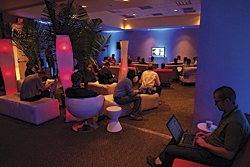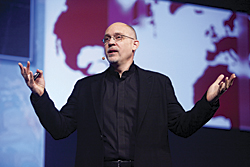ArcUser Online
This article as a PDF . If success is measured by the din of collaborative exchange, then the 2010 Esri Developer Summit, held March 22�25, was a triumph. One could barely walk 10 feet without overhearing attendees exchanging ideas about how they had improved their work with GIS tools. The conference demonstrated how sharing individual innovations can inspire the development of solutions that extend the reach of GIS to the world. Last year, user presentations were added to the Developer Summit. This year, the number of presentations by developers doubled and covered a wide range of topics. Many presentations packed the largest rooms at the venue and were followed by spirited and informative Q&A sessions that were continued in the lobby of the Palm Springs Convention Center where the conference was held. User presentations were selected by Esri based on their usefulness in tackling everyday problems. Vish Uma of Timmons Group was a standout among user presenters. He gave two presentations on common obstacles that developers face. His first presentation, on continuous integration (CI), highlighted the commonality in workflows across a dauntingly wide spectrum of software and organizations. [CI is an approach to quality control in software development that reduces integration problems by having team members integrate their work frequently so errors will be detected as quickly as possible.] Uma shared best practices for overcoming the challenges posed by the GIS software development process and explained how he optimized his workflow through automation. "One of my big revelations with the last release of ArcGIS was how many tasks I could eliminate from my schedule by simply automating them," said Uma. "All of a sudden, building and deploying solutions became more fun and opened new avenues of inspiration. That's why CI is so important." One attendee commented that he had no idea how much time he wasted with manual configuration and now sees how he can automate key aspects of his work. In his second presentation, Uma demonstrated how he overcame current Web client printing limitations. He shared the architecture behind a printing service he built for Timmons. The service was invaluable in overcoming well-known limitations, such as the inability to print multiple map services over a basemap. "Talking to Esri technicians over the years has helped me find workable solutions to real problems," said Uma. "It's rewarding to be able to pay Esri back for their assistance by helping my peers. It's what Jack Dangermond means by 'GIS community.'" More than half the user presentations were about using Esri's APIs in a multitude of scenarios. Many were excellent. Brenden Collins and Steven Andari from Blue Raster software gave a presentation on their ArcGIS Server/Flex "super-mashup" for the Southern Forest for the Future Project. Their project integrated YouTube and Flickr, as well as Web Map Services (WMS) and KML, into a rich Web application that uses dynamic map caching to create a time series showing urban sprawl. "The service raises awareness about the invaluable resources that forests provide, like fresh water, timber, and recreation," said Collins. This was Collins' first Esri Developer Summit, and he was overwhelmed by the availability of Esri staff on the showcase floor. "I found myself gravitating to the Flex and geoprocessing teams with all my nagging questions and getting immediate answers," he added. "That was enormously helpful and a pleasant surprise." Developers responded to the 2010 Mashup Challenge with many novel entries. The guidelines were simple: build a mashup using Esri's ArcGIS online content and Web APIs, publish the related URL, and post a video describing the application on YouTube. Dave Bouwman, CTO and lead software architect at DTSAgile of Fort Collins, Colorado, took the top prize of $10,000. His Executive Compensation Mashup compared top U.S. executive salaries with the total income for selected counties in the United States. Presentations by Bouwman and his DTSAgile colleague Brian Noyle were some of the most well attended of the conference. One of Bouwman's presentations, Ruby-fu: Using ArcGIS Server with Rails, explained how Ruby on Rails, the popular Web development platform that powers Twitter, Hulu, and Basecamp, can be configured to work with ArcGIS Server.
One of Noyle's presentations covered writing iPhone and Android apps without learning Objective-C code. Noyle demonstrated the design and implementation of a geocoding-enabled site for location-based feedback within a user's local community. Many developers made a beeline for the technical sessions, especially the ones that previewed the capabilities of ArcGIS 10. Esri's Jeremy Bartley and Keyur Shah demonstrated how to create maps; execute queries; perform geoprocessing, geocoding, and geometry operations; access tiles; and generate KML using the REST API. Attendees learned how to use the REST API in a variety of mashups that also used JavaScript, HTML, Google Earth, Python, and other Web technologies. "I noticed that the really popular sessions focused on extending servers through .NET and Java," said Bartley. "One of the exciting developments at ArcGIS 10 is that it supports writing custom server object extensions that can be consumed in both SOAP and REST services, which is hugely significant to developers." Bartley also kicked off the Plenary Session with the unveiling and demonstration of ArcGIS.com, an online resource for finding and using geographic content from Esri and many other sources. ArcGIS.com will give developers a platform to share applications through links and through code. "From a developer perspective, this is exciting because programmers can share their information securely within groups. It also includes all the Web APIs—Flex, JavaScript, and iPhone as well—which are integral to building solutions today," said Bartley. Scott Morehouse, Esri's director of software development, provided an overview of the impending release, ArcGIS 10, during the plenary. Morehouse also introduced ArcGIS.com, which he described as a "Web gateway into the ArcGIS system." When ArcGIS.com goes online, it will serve as an online GIS resource where visitors can find basemaps created by Esri and the ArcGIS community, make maps and create mashups, search the Web or GIS servers for additional content for the maps, share maps, view sample applications, and download source codes. Keynote speaker David Chappell, principal of Chappell and Associates, delivered an engaging address on cloud platform development. He differentiated between cloud computing applications and platforms, discussed new and future trends on this platform, and explained the importance of building and deploying GIS applications in the cloud. Chappell observed that in the last 50 years, only five platforms have emerged for business computing: mainframes, minicomputers, personal computers (PCs), PC-based servers, and mobile phones. "We are right now, I believe, witnessing the birth of the sixth platform type. It is cloud platforms," he said. "As a software developer—as anyone who cares about code—you ought to think in a big way about cloud platforms." Despite a wheezing economy, the turnout for the 2010 Esri Developer Summit, now in its fifth year, was stronger than ever. Once again, this year's summit brought GIS developers and Esri software development teams together to develop better tools, applications, and practices. |

